Investigation of Fatigue Crack Growth in Full-Scale Railway Axles Subjected to Service Load Spectra: Experiments and Predictive Models
Abstract
:1. Introduction
2. Material and Experimental Setup
2.1. Specimens and Test Details of Full-Scale Axle Tests
2.2. Experimental Setup and Test Details of Fatigue Crack Propagation Tests
3. Experimental Results
3.1. Results of the Full-Scale Tests
3.2. Fatigue Crack Propagation Tests Results
4. Crack Growth Models and Parameter Determination
4.1. Calibration of the Nasgro Equation
4.2. Calibration of the Modified Nasgro Equation
5. Residual Lifetime Predictions
Crack Growth Algorithm
- Given a block load level, the local load ratio R acting at the points a and c of the crack is calculated by using Equation (8).In the case of superposition of rotating bending and residual stresses, the effective R is changing between along the crack propagation path. On the other hand, for the analysis carried out considering only the rotating bending stresses, the load ratio is always R = −1.
- Evaluation of the SIFs acting at the two points a and c adopting the Wang–Lambert weight function and the normal stress distribution perpendicular to the crack plane for the un-cracked axle calculated with the FE model.
- Given the stress intensity factor ranges and the R, for both points a and c, evaluation of the crack growth rates using the conventional Nasgro equation and Modified Nasgro equation (see Section 4). The evaluated crack growth rates for axle S067 has been shown in Figure 8. According to the modified Nasgro equation, at the beginning of the simulation the crack growth rates tend to decrease with crack propagation due to crack closure development. Finally, when the crack closure fully develops and the driving force increases due to the crack advancement, the crack growth rates increase and converge along the Paris region.
- Updating the actual crack size and shape, which acted as an input for the following load block.
- Simulations are run until a crack depth of 20 mm is reached.
6. Results and Discussion
6.1. Crack Shape Evolution
6.2. Effect of Closure Development
7. Concluding Remarks
- Adopting the concept of cyclic R-curve through the Modified Nasgro equation leads to axle life predictions that are in good agreement with the full-scale experimental results (max underestimation less than 30%) if all the contribution to mean stresses (press-fit stresses + residual stresses) are included in the analysis.
- The conventional Nasgro equation leads to significant overestimation of propagation lifetime, approximately by a factor 2.2, in the real service scenario for railway axles when the majority of the load classes in the load spectrum corresponds to which are below the long crack threshold.
Author Contributions
Funding
Institutional Review Board Statement
Informed Consent Statement
Data Availability Statement
Acknowledgments
Conflicts of Interest
Abbreviations
| SIF | Stress intensity factor |
| R | Load (or stress) ratio |
| EDM | Electrical discharge machining |
| EA4T | 25CrMo4 steel |
| CPCA | Compression pre-cracking constant-amplitude |
| CPLR | Compression pre-cracking Load reduction |
References
- Gravier, N.; Viet, J.J.; Leluan, A. Predicting the life cycle of railway axles. Rev. Gen. Chemins Fer 1999, 3, 33–40. [Google Scholar]
- Watson, A. Implications of Impact Damage on the Structural Integrity of Axles. 2010. Available online: http://esistc24.mecc.polimi.it/index.html (accessed on 7 July 2021).
- Wu, S.; Xu, Z.; Kang, G.; He, W. Probabilistic fatigue assessment for high-speed railway axles due to foreign object damages. Int. J. Fatigue 2018, 117, 90–100. [Google Scholar] [CrossRef]
- Beretta, S.; Carboni, M.; Lo Conte, A.; Palermo, E. An investigation of the effects of corrosion on the fatigue strength of AlN axle steel. Proc. Inst. Mech. Eng. Part F J. Rail Rapid Transit 2008, 222, 129–143. [Google Scholar] [CrossRef]
- Foletti, S.; Beretta, S.; Gurer, G. Defect acceptability under full-scale fretting fatigue tests for railway axles. Int. J. Fatigue 2016, 86, 34–43. [Google Scholar] [CrossRef]
- Pourheidar, A.; Regazzi, D.; Cervello, S.; Foletti, S.; Beretta, S. Fretting fatigue analysis of full-scale railway axles in presence of artificial micro-notches. Tribol. Int. 2020, 150, 106383. [Google Scholar] [CrossRef]
- Schmidová, E.; Paščenko, P.; Culek, B.; Schmid, M. Premature failures of railway axles after repeated pressing. Eng. Fail. Anal. 2021, 123, 105253. [Google Scholar] [CrossRef]
- Osgood, C. Damage-tolerant design (Safe-life and fail-safe structural design philosophies in fatigue damage and operating lifetime control). Mach. Des. 1969, 41, 91–95. [Google Scholar]
- Combes, R.C., Jr. Design for damage tolerance. J. Aircr. 1970, 7, 18–20. [Google Scholar] [CrossRef]
- Zerbst, U.; Vormwald, M.; Andersch, C.; Mädler, K.; Pfuff, M. The development of a damage tolerance concept for railway components and its demonstration for a railway axle. Eng. Fract. Mech. 2005, 72, 209–239. [Google Scholar] [CrossRef]
- Zerbst, U.; Lundén, R.; Edel, K.O.; Smith, R.A. Introduction to the damage tolerance behaviour of railway rails—A review. Eng. Fract. Mech. 2009, 76, 2563–2601. [Google Scholar] [CrossRef] [Green Version]
- Project WIDEM. Available online: http://www.widem.org/ (accessed on 17 February 2021).
- Project EURAXLES. Available online: http://www.euraxles.eu (accessed on 17 February 2021).
- Project MARAXIL. Available online: http://maraxil.mecc.polimi.it/ (accessed on 17 February 2021).
- Beretta, S.; Carboni, M. Variable amplitude fatigue crack growth in a mild steel for railway axles: Experiments and predictive models. Eng. Fract. Mech. 2011, 78, 848–862. [Google Scholar] [CrossRef]
- Traupe, M.; Jenne, S.; Lütkepohl, K.; Varfolomeev, I. Experimental validation of inspection intervals for railway axles accompanying the engineering process. Int. J. Fatigue 2016, 86, 44–51. [Google Scholar] [CrossRef]
- Sander, M.; Richard, H. Investigations on fatigue crack growth under variable amplitude loading in wheelset axles. Eng. Fract. Mech. 2011, 78, 754–763. [Google Scholar] [CrossRef]
- Cao, W.; Koh, C.; Smith, I. Enhancing static-load-test identification of bridges using dynamic data. Eng. Struct. 2019, 186, 410–420. [Google Scholar] [CrossRef]
- Yamamoto, M.; Makino, K.; Ishiduka, H. Experimental validation of railway axle fatigue crack growth using operational loading. Eng. Fract. Mech. 2019, 213, 142–152. [Google Scholar] [CrossRef]
- Rieger, M.; Moser, C.; Brunnhofer, P.; Simunek, D.; Weber, F.J.; Deisl, A.; Gänser, H.P.; Pippan, R.; Enzinger, N. Fatigue crack growth in full-scale railway axles–Influence of secondary stresses and load sequence effects. Int. J. Fatigue 2020, 132, 105360. [Google Scholar] [CrossRef]
- Hu, Y.; Qin, Q.; Wu, S.; Zhao, X.; Wang, W. Fatigue resistance and remaining life assessment of induction-hardened S38C steel railway axles. Int. J. Fatigue 2021, 144, 106068. [Google Scholar] [CrossRef]
- Yasniy, O.; Lapusta, Y.; Pyndus, Y.; Sorochak, A.; Yasniy, V. Assessment of lifetime of railway axle. Int. J. Fatigue 2013, 50, 40–46. [Google Scholar] [CrossRef]
- Pokornỳ, P.; Hutař, P.; Náhlík, L. Residual fatigue lifetime estimation of railway axles for various loading spectra. Theor. Appl. Fract. Mech. 2016, 82, 25–32. [Google Scholar] [CrossRef]
- De Freitas, M.; François, D. Analysis of fatigue crack growth in rotary bend specimens and railway axles. Fatigue Fract. Eng. Mater. Struct. 1995, 18, 171–178. [Google Scholar] [CrossRef]
- Zerbst, U.; Schödel, M.; Beier, H.T. Parameters affecting the damage tolerance behaviour of railway axles. Eng. Fract. Mech. 2011, 78, 793–809. [Google Scholar] [CrossRef] [Green Version]
- Lundén, R.; Vernersson, T.; Ekberg, A. Railway axle design: To be based on fatigue initiation or crack propagation? Proc. Inst. Mech. Eng. Part F J. Rail Rapid Transit 2010, 224, 445–453. [Google Scholar] [CrossRef]
- Forman, R.G.; Mettu, S.R. Behavior of Surface and Corner Cracks Subjected to Tensile and Bending Loads in Ti-6Al-4V Alloy; NASA: Washington, DC, USA, 1990. [Google Scholar]
- Beretta, S.; Carboni, M.; Cantini, S.; Ghidini, A. Application of fatigue crack growth algorithms to railway axles and comparison of two steel grades. Proc. Inst. Mech. Eng. Part F J. Rail Rapid Transit 2004, 218, 317–326. [Google Scholar] [CrossRef]
- Madia, M.; Beretta, S.; Zerbst, U. An investigation on the influence of rotary bending and press fitting on stress intensity factors and fatigue crack growth in railway axles. Eng. Fract. Mech. 2008, 75, 1906–1920. [Google Scholar] [CrossRef] [Green Version]
- Regazzi, D.; Beretta, S.; Carboni, M. An investigation about the influence of deep rolling on fatigue crack growth in railway axles made of a medium strength steel. Eng. Fract. Mech. 2014, 131, 587–601. [Google Scholar] [CrossRef]
- Regazzi, D.; Cantini, S.; Cervello, S.; Foletti, S.; Pourheidar, A.; Beretta, S. Improving fatigue resistance of railway axles by cold rolling: Process optimisation and new experimental evidences. Int. J. Fatigue 2020, 137, 105603. [Google Scholar] [CrossRef]
- Makino, T.; Sakai, H.; Kozuka, C.; Yamazaki, Y.; Yamamoto, M.; Minoshima, K. Overview of fatigue damage evaluation rule for railway axles in Japan and fatigue property of railway axle made of medium carbon steel. Int. J. Fatigue 2020, 132, 105361. [Google Scholar] [CrossRef]
- Maierhofer, J.; Pippan, R.; Gänser, H.P. Modified NASGRO equation for physically short cracks. Int. J. Fatigue 2014, 59, 200–207. [Google Scholar] [CrossRef] [Green Version]
- Tanaka, K.; Akiniwa, Y. Resistance-curve method for predicting propagation threshold of short fatigue cracks at notches. Eng. Fract. Mech. 1988, 30, 863–876. [Google Scholar] [CrossRef]
- Tanaka, K.; Nakai, Y. Propagation and non-propagation of short fatigue cracks at a sharp notch. Fatigue Fract. Eng. Mater. Struct. 1983, 6, 315–327. [Google Scholar] [CrossRef]
- Tabernig, B.; Pippan, R. Determination of the length dependence of the threshold for fatigue crack propagation. Eng. Fract. Mech. 2002, 69, 899–907. [Google Scholar] [CrossRef]
- Maierhofer, J.; Kolitsch, S.; Pippan, R.; Gänser, H.P.; Madia, M.; Zerbst, U. The cyclic R-curve–determination, problems, limitations and application. Eng. Fract. Mech. 2018, 198, 45–64. [Google Scholar] [CrossRef]
- Pokornỳ, P.; Vojtek, T.; Náhlík, L.; Hutař, P. Crack closure in near-threshold fatigue crack propagation in railway axle steel EA4T. Eng. Fract. Mech. 2017, 185, 2–19. [Google Scholar] [CrossRef]
- Vojtek, T.; Pokornỳ, P.; Kuběna, I.; Náhlík, L.; Fajkoš, R.; Hutař, P. Quantitative dependence of oxide-induced crack closure on air humidity for railway axle steel. Int. J. Fatigue 2019, 123, 213–224. [Google Scholar] [CrossRef]
- Maierhofer, J.; Gänser, H.P.; Simunek, D.; Leitner, M.; Pippan, R.; Luke, M. Fatigue crack growth model including load sequence effects–Model development and calibration for railway axle steels. Int. J. Fatigue 2020, 132, 105377. [Google Scholar] [CrossRef]
- BS EN13261. Railway Applications–Wheelsets and Bogies–Axles–Product Requirements; European Committee for Standardization: Brussels, Belgium, 2003. [Google Scholar]
- Gao, J.W.; Dai, G.Z.; Li, Q.Z.; Zhang, M.N.; Zhu, S.P.; Correia, J.A.; Lesiuk, G.; De Jesus, A.M. Fatigue assessment of EA4T railway axles under artificial surface damage. Int. J. Fatigue 2021, 146, 106157. [Google Scholar] [CrossRef]
- Carboni, M.; Cantini, S. Advanced ultrasonic “Probability of Detection” curves for designing in-service inspection intervals. Int. J. Fatigue 2016, 86, 77–87. [Google Scholar] [CrossRef]
- Joint Sector Group for ERA Task Force on Wagon/Axle Maintenance. Broken Wheelset Axles in Europa Since 1996 (without Hot Axle Boxes); European Railway Agency: Lille, France, 2010. [Google Scholar]
- Transportation Safety Board of Canada. Railway Investigation Report Number R01Q0010; Transportation Safety Board of Canada: Gatineau, QB, Canada, 2003. [Google Scholar]
- Zerbst, U.; Beretta, S.; Köhler, G.; Lawton, A.; Vormwald, M.; Beier, H.T.; Klinger, C.; Černỳ, I.; Rudlin, J.; Heckel, T.; et al. Safe life and damage tolerance aspects of railway axles—A review. Eng. Fract. Mech. 2013, 98, 214–271. [Google Scholar] [CrossRef]
- Pippan, R.; Plöchl, L.; Klanner, F.; Stüwe, H. The use of fatigue specimens precracked in compression for measuring threshold values and crack growth. J. Test. Eval. 1994, 22, 98–103. [Google Scholar]
- Newman, J., Jr.; Yamada, Y. Compression precracking methods to generate near-threshold fatigue-crack-growth-rate data. Int. J. Fatigue 2010, 32, 879–885. [Google Scholar] [CrossRef]
- Pippan, R. The growth of short cracks under cyclic compression. Fatigue Fract. Eng. Mater. Struct. 1987, 9, 319–328. [Google Scholar] [CrossRef]
- Pourheidar, A.; Patriarca, L.; Werner, T.; Madia, M.; Beretta, S. Advancements in the measurement and application of the cyclic R-curve for fatigue assessment. Eng. Fract. Mech. 2021. submitted. [Google Scholar]
- Wang, X.; Lambert, S. Stress intensity factors for low aspect ratio semi-elliptical surface cracks in finite-thickness plates subjected to nonuniform stresses. Eng. Fract. Mech. 1995, 51, 517–532. [Google Scholar] [CrossRef]
- Nasgro, B. Fracture Mechanics and Fatigue Crack Growth Analysis Software; MIT: Cambridge, MA, USA, 2002. [Google Scholar]
- Elber, W. The significance of fatigue crack closure. In Damage Tolerance in Aircraft Structures; ASTM International: West Conshohocken, PA, USA, 1971. [Google Scholar]
- El Haddad, M.; Smith, K.; Topper, T. Fatigue crack propagation of short cracks. J. Eng. Mater. Technol. 1979, 101, 42–46. [Google Scholar] [CrossRef]
- Pourheidar, A.; Beretta, S.; Ragazzi, D.; Baykara, C. Comparison of SIF solutions for cracks under rotating bending and their impact upon propagation lifetime of railway axles. Procedia Struct. Integr. 2018, 8, 610–617. [Google Scholar] [CrossRef]
- Shiratori, M.; Miyoshi, T. Analysis of stress intensity factors for surface cracks subjected to arbitrarily distributed stresses. In Computational Mechanics’ 86; Springer: Berlin/Heidelberg, Germany, 1986; pp. 1027–1032. [Google Scholar]
- Pommier, S.; Sakae, C.; Murakami, Y. An empirical stress intensity factor set of equations for a semi-elliptical crack in a semi-infinite body subjected to a polynomial stress distribution. Int. J. Fatigue 1999, 21, 243–251. [Google Scholar] [CrossRef]
- Carpinteri, A. Elliptical-arc surface cracks in round bars. Fatigue Fract. Eng. Mater. Struct. 1992, 15, 1141–1153. [Google Scholar] [CrossRef]
- Varfolomeev, I.; Luke, M.; Moroz, S. Experimental and numerical investigations of fatigue crack growth in various specimen geometries. Procedia Eng. 2010, 2, 1829–1837. [Google Scholar] [CrossRef]
- Newman, J.; Raju, I. Stress-intensity factor equations for cracks in three-dimensional finite bodies subjected to tension and bending loads. Comput. Methods Mech. Fract. 1986, 2, 311–334. [Google Scholar]
- Levan, A.; Royer, J. Part-circular surface cracks in round bars under tension, bending and twisting. Int. J. Fract. 1993, 61, 71–99. [Google Scholar] [CrossRef]
- Newman, J. A crack-closure model for predicting fatigue crack growth under aircraft spectrum loading. In Methods and Models for Predicting Fatigue Crack Growth under Random Loading; ASTM International: West Conshohocken, PA, USA, 1981. [Google Scholar]
- James, M.N.; Hattingh, D.; Asquith, D.; Newby, M.; Doubell, P. Residual stresses in condition monitoring and repair of thermal power generation components. Theor. Appl. Fract. Mech. 2017, 92, 289–297. [Google Scholar] [CrossRef]
- Wu, S.; Liu, Y.; Li, C.; Kang, G.; Liang, S. On the fatigue performance and residual life of intercity railway axles with inside axle boxes. Eng. Fract. Mech. 2018, 197, 176–191. [Google Scholar] [CrossRef]
- Hannemann, R.; Sander, M. Effect of specimen geometry and press-fit on the stress intensity factor solution for scaled wheelset axles under bending. Procedia Struct. Integr. 2016, 2, 2527–2534. [Google Scholar] [CrossRef] [Green Version]
- Gänser, H.P.; Maierhofer, J.; Tichy, R.; Zivkovic, I.; Pippan, R.; Luke, M.; Varfolomeev, I. Damage tolerance of railway axles—The issue of transferability revisited. Int. J. Fatigue 2016, 86, 52–57. [Google Scholar] [CrossRef]
- Náhlík, L.; Pokornỳ, P.; Ševčík, M.; Fajkoš, R.; Matušek, P.; Hutař, P. Fatigue lifetime estimation of railway axles. Eng. Fail. Anal. 2017, 73, 139–157. [Google Scholar] [CrossRef]
- Hassani-Gangaraj, S.M.; Carboni, M.; Guagliano, M. Finite element approach toward an advanced understanding of deep rolling induced residual stresses, and an application to railway axles. Mater. Des. 2015, 83, 689–703. [Google Scholar] [CrossRef]
- Pokornỳ, P.; Dlhỳ, P.; Poduška, J.; Fajkoš, R.; Vojtek, T.; Náhlík, L.; Grasso, M.; Hutař, P. Influence of heat treatment-induced residual stress on residual fatigue life of railway axles. Theor. Appl. Fract. Mech. 2020, 109, 102732. [Google Scholar] [CrossRef]
- Schajer, G.S. Advances in hole-drilling residual stress measurements. Exp. Mech. 2010, 50, 159–168. [Google Scholar] [CrossRef]
- Beretta, S.; Carboni, M.; Regazzi, D. Load interaction effects in propagation lifetime and inspections of railway axles. Int. J. Fatigue 2016, 91, 423–433. [Google Scholar] [CrossRef]
- Newman, J.C., Jr. FASTRAN-2: A fatigue crack growth structural analysis program. NASA STI/Recon Tech. Rep. N 1992, 92, 30964. [Google Scholar]
- Zerbst, U.; Vormwald, M.; Pippan, R.; Gänser, H.P.; Sarrazin-Baudoux, C.; Madia, M. About the fatigue crack propagation threshold of metals as a design criterion—A review. Eng. Fract. Mech. 2016, 153, 190–243. [Google Scholar] [CrossRef]
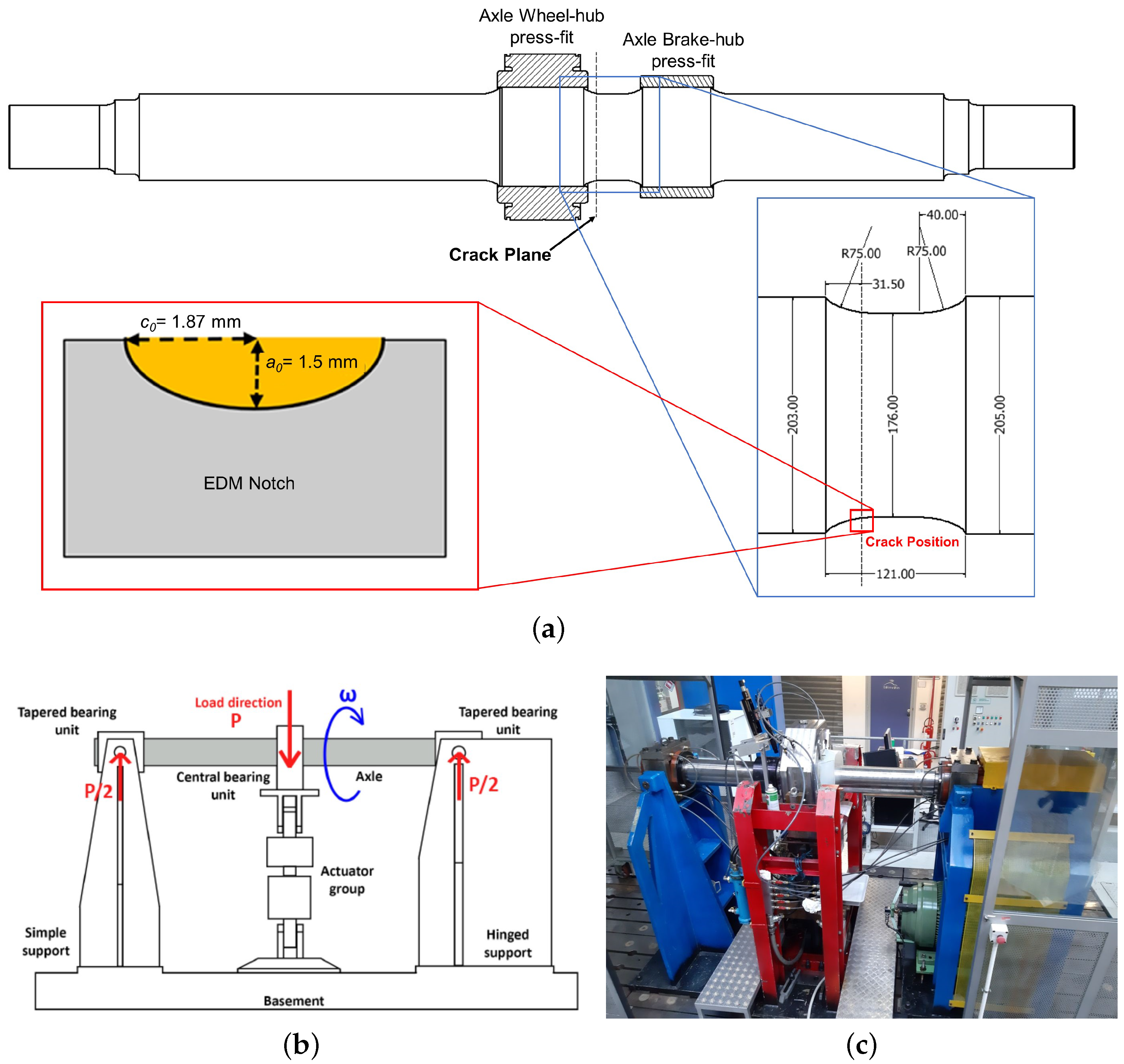
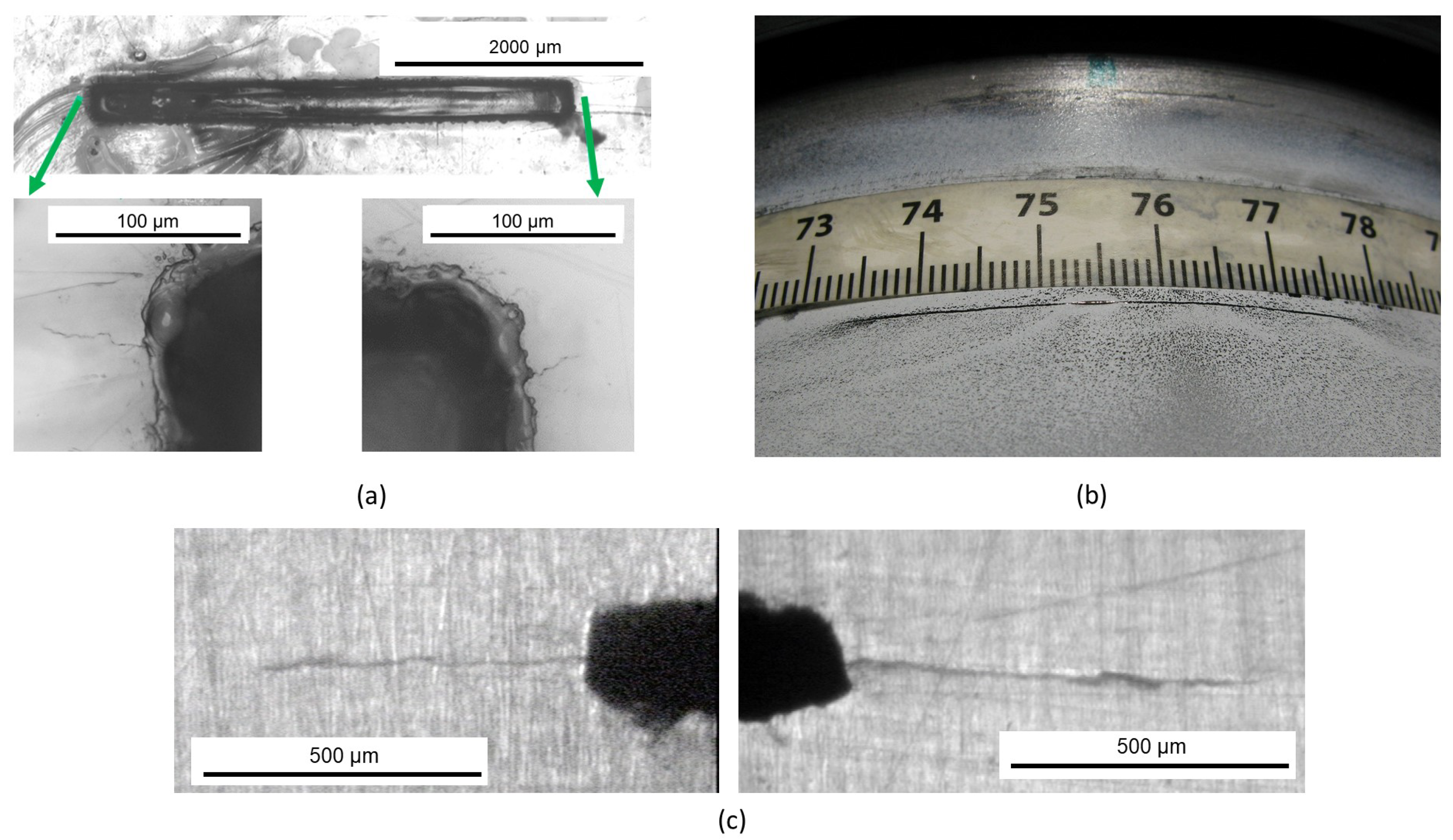
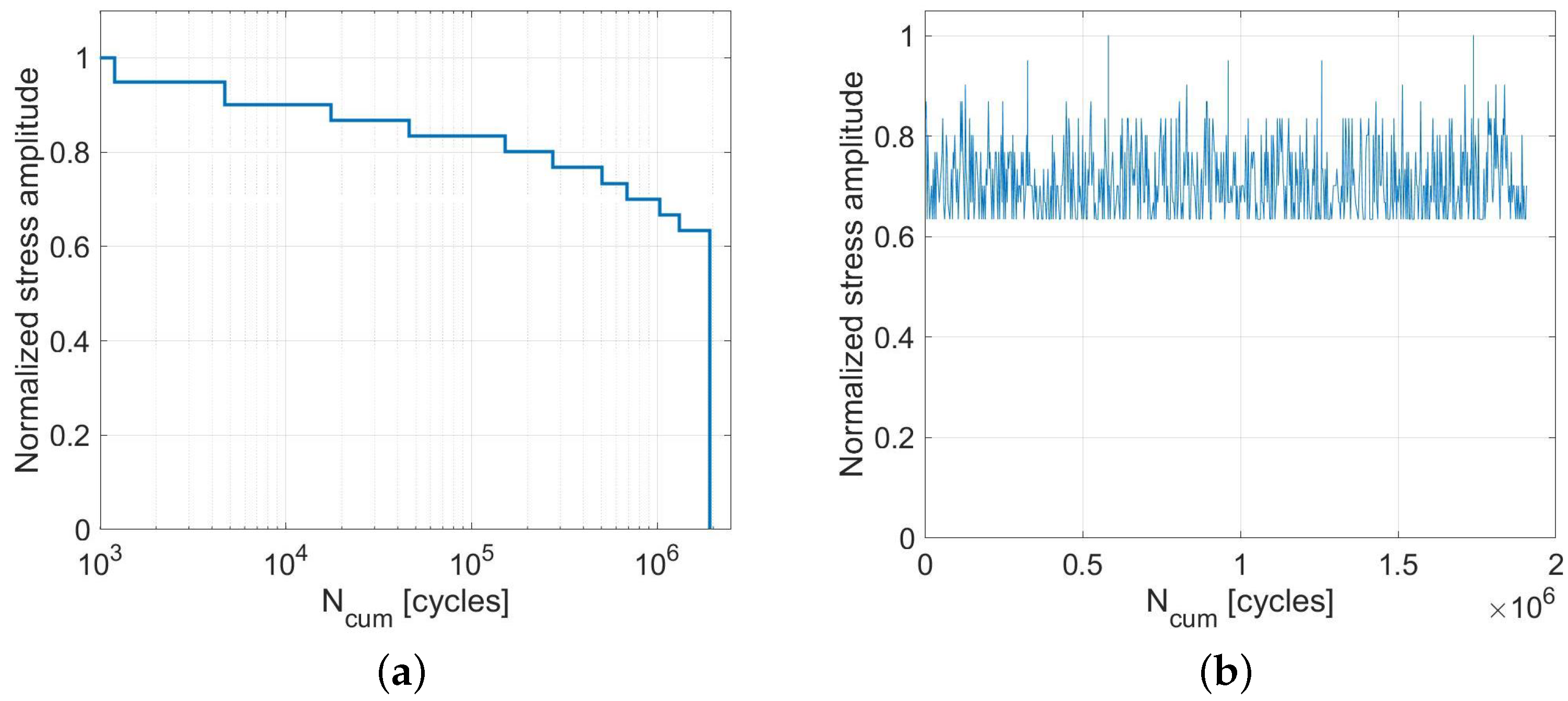

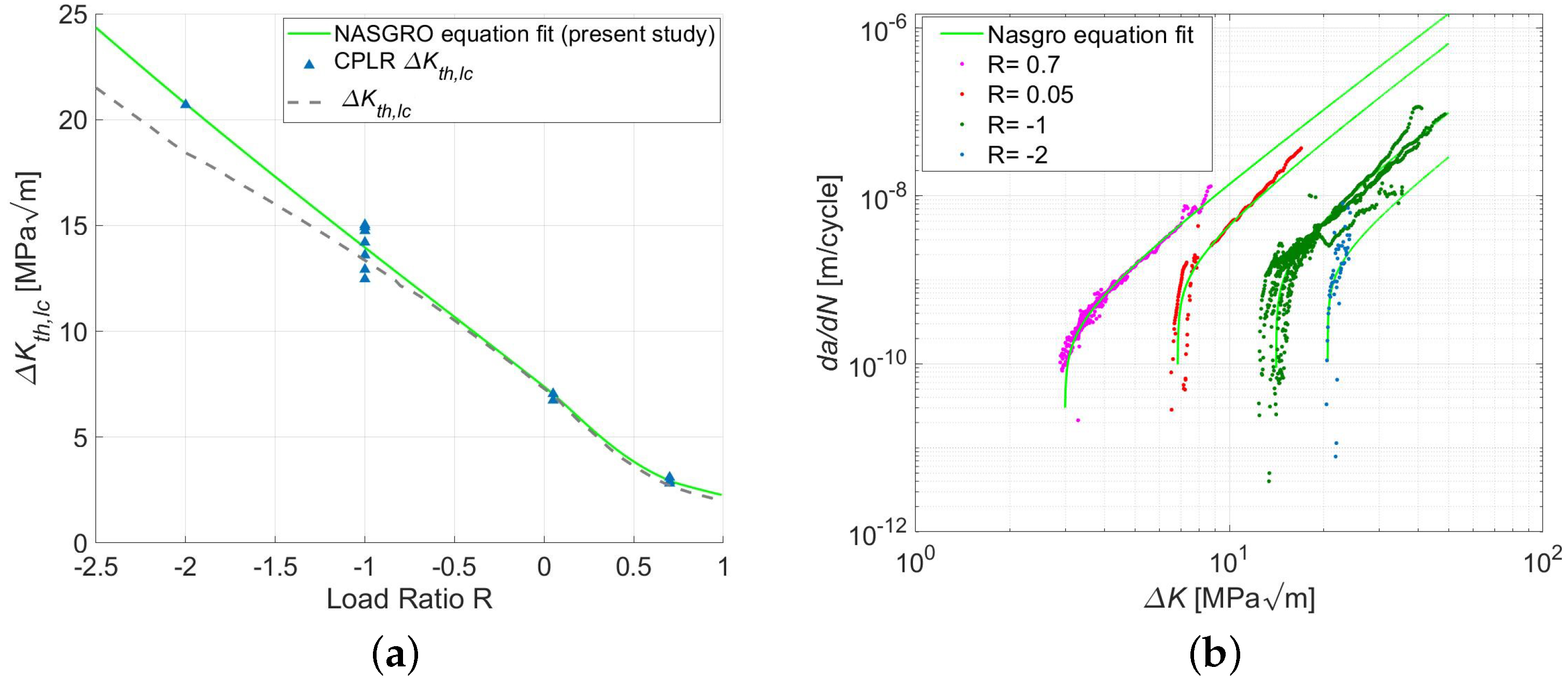
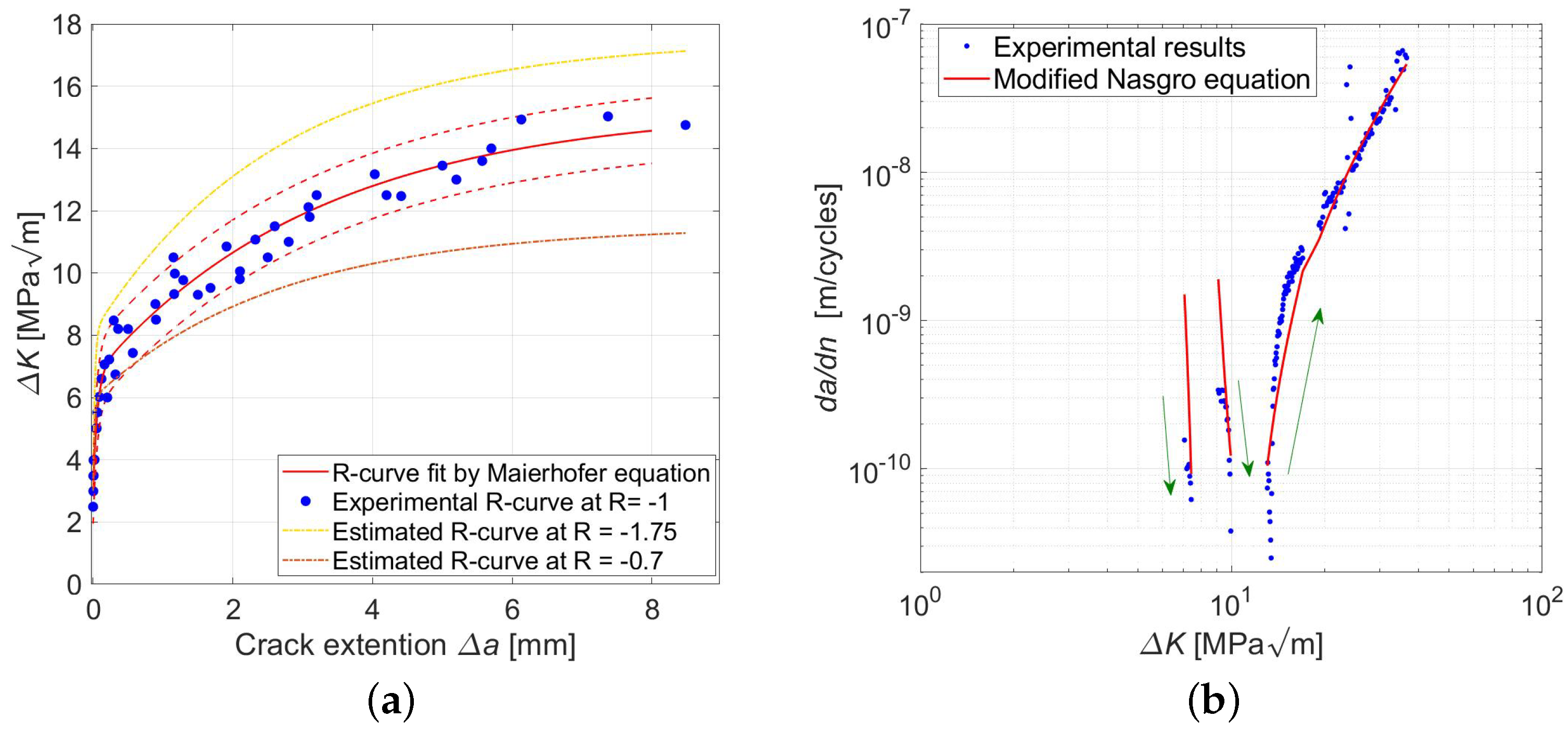



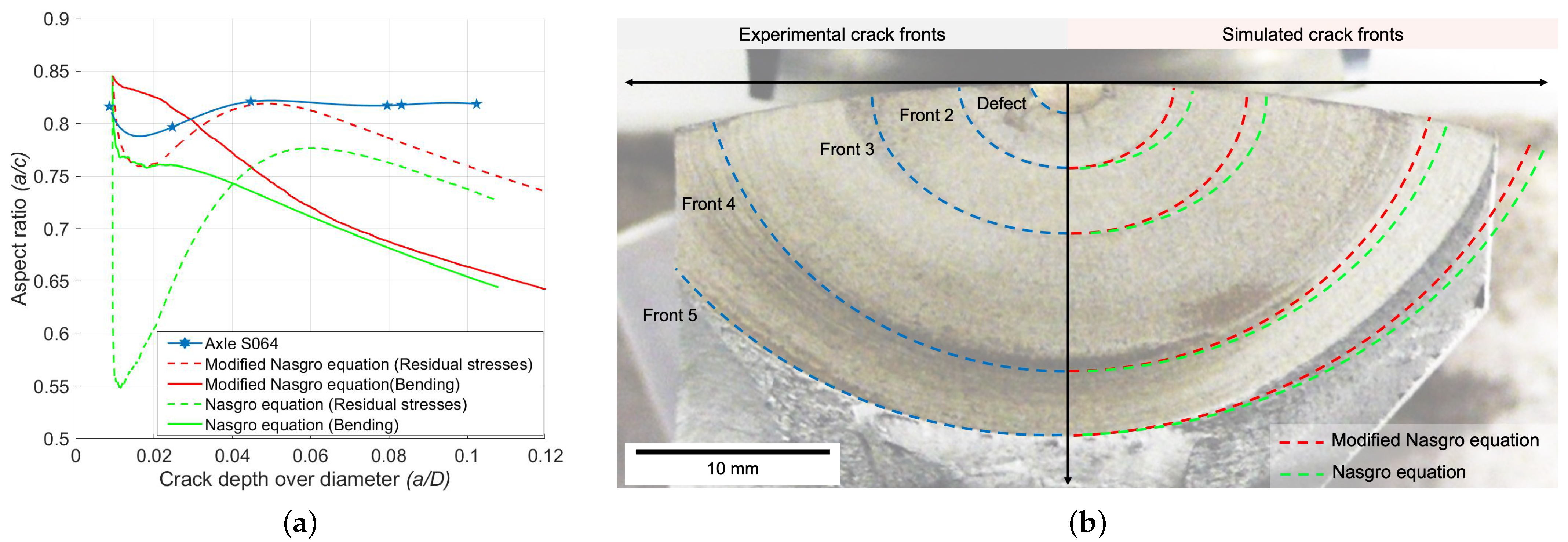
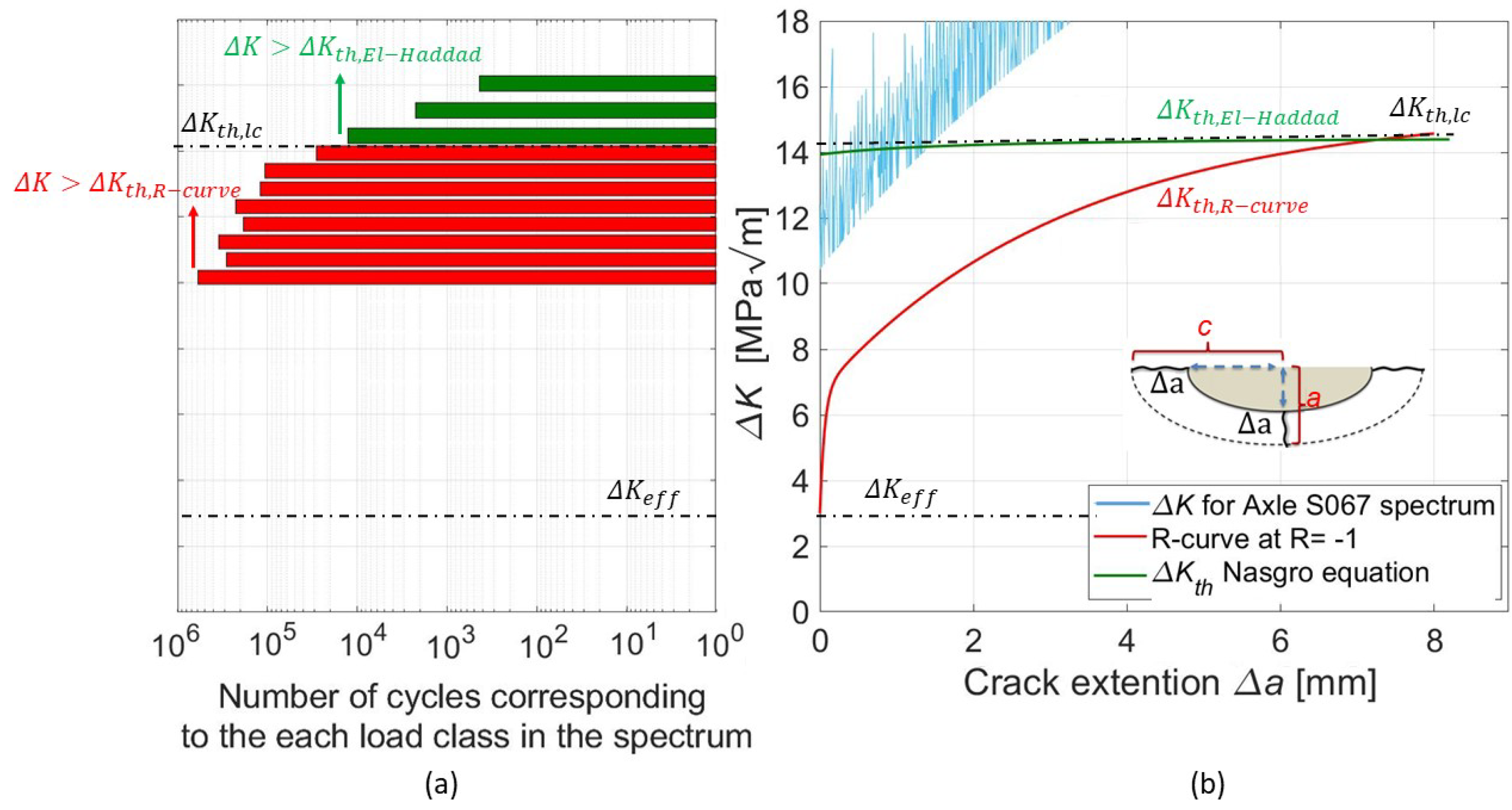
| Yield Stress | Ultimate Tensile Stress | Strain at Failure |
|---|---|---|
| (MPa) | (MPa) | (%) |
| 549 ± 43 | 707 ± 34 | 22.5 ± 1.5 |
| Load Ratio | Testing Procedure | Number of Tests | Mean (MPa) |
|---|---|---|---|
| 0.7 | CPLR/CPCA | 3 | 2.95 |
| 0.05 | CPLR/CPCA | 3 | 6.87 |
| −1 | CPLR/CPCA | 9 | 14.6 |
| −2 | CPLR | 1 | 21.7 |
| Axle | Maximum at Deepest Point of the Crack (a) (Normalized by ) | Maximum at Surface Point of the Crack (c) (Normalized by ) | Percentage of Load Blocks below for Deepest Point of Crack (a) | Percentage of Load Blocks below for Surface Point of Crack (c) | Number of Cycles to Failure | Finial Crack Dimension at Failure (mm) |
|---|---|---|---|---|---|---|
| S064 | 1.19 | 1.38 | 97.7% | 64.5% | 3,375,000 | a = 16.7 c = 22.01 |
| S065 | 1.09 | 1.27 | 99.8% | 85.8% | 5,600,000 | a = 25.6 c = 36 |
| S066 | 1.11 | 1.29 | 99.8% | 85.8% | 5,775,000 | a = 26.1 c = 35.4 |
| S067 | 1.03 | 1.20 | 99.98% | 98.1% | 9,150,000 | a = 29 c = 50.5 |
| Axle | Maximum at Deepest Point of the Crack (a) (Normalized by ) | Maximum at Surface Point of the Crack (c) (Normalized by ) | Number of Cycles at Crack Depth = 20 mm | Modified Nasgro Equation (Cycle) | Nasgro Equation (Cycle) |
|---|---|---|---|---|---|
| S064 | 1.19 | 1.38 | 3,375,000 | B = 2,036,000 B + R = 2,287,000 | B = 1,852,000 B + R = 5,014,000 |
| S065 | 1.09 | 1.27 | 5,230,000 | B = 3,319,000 B + R = 4,234,000 | B = 7,495,000 B+R= 10,850,000 |
| S066 | 1.11 | 1.29 | 5,420,000 | B = 3,317,000 B + R = 4,230,000 | B = 6,718,000 B + R = 10,250,000 |
| S067 | 1.03 | 1.20 | 8,920,000 | B = 4,725,000 B + R = 7,700,000 | B = 12,030,000 B + R = 19,570,000 |
Publisher’s Note: MDPI stays neutral with regard to jurisdictional claims in published maps and institutional affiliations. |
© 2021 by the authors. Licensee MDPI, Basel, Switzerland. This article is an open access article distributed under the terms and conditions of the Creative Commons Attribution (CC BY) license (https://creativecommons.org/licenses/by/4.0/).
Share and Cite
Pourheidar, A.; Patriarca, L.; Beretta, S.; Regazzi, D. Investigation of Fatigue Crack Growth in Full-Scale Railway Axles Subjected to Service Load Spectra: Experiments and Predictive Models. Metals 2021, 11, 1427. https://doi.org/10.3390/met11091427
Pourheidar A, Patriarca L, Beretta S, Regazzi D. Investigation of Fatigue Crack Growth in Full-Scale Railway Axles Subjected to Service Load Spectra: Experiments and Predictive Models. Metals. 2021; 11(9):1427. https://doi.org/10.3390/met11091427
Chicago/Turabian StylePourheidar, Amir, Luca Patriarca, Stefano Beretta, and Daniele Regazzi. 2021. "Investigation of Fatigue Crack Growth in Full-Scale Railway Axles Subjected to Service Load Spectra: Experiments and Predictive Models" Metals 11, no. 9: 1427. https://doi.org/10.3390/met11091427






